1 of 13
Download to read offline


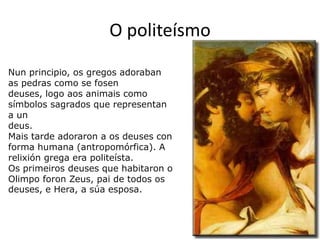


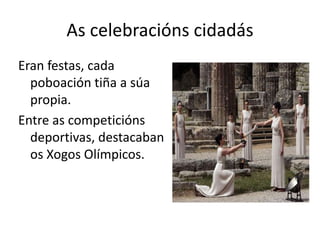
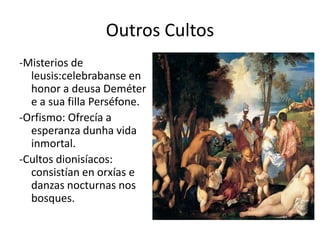
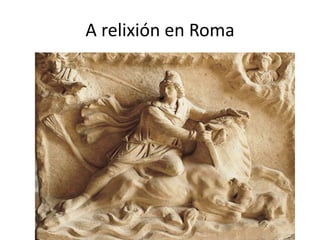
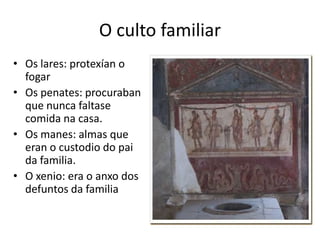


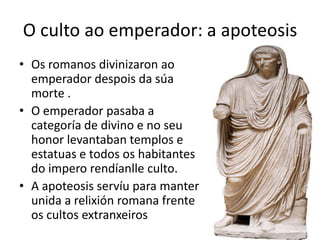
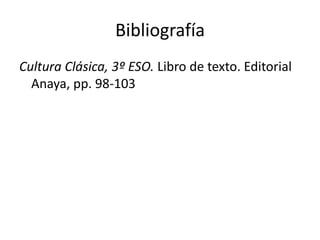
Ad
Recommended
The Augean Stables
The Augean Stablesdomenechino
Ěý
The king of Elis, Augeas, had extremely dirty stables that had not been cleaned in many years due to his laziness. For one of his labors, Heracles was tasked with cleaning the Augean stables, deemed an impossible task. Heracles came up with a clever solution, knocking holes in the walls and diverting two nearby rivers through the stables to wash away all the built up dung. Within a few hours, the rushing waters had swept the stables completely clean, completing the task.MITOLOXĂŤA GREGA.pdf
MITOLOXĂŤA GREGA.pdfVanessa FelĂpez
Ěý
PresentaciĂłn dos principais deuses e deusas do Olimpo, cunha pequena lenda relacionada.
O legado cultural greco-latino
O legado cultural greco-latinomaribeliglesias64
Ěý
Aportacións da cultura greco-latina á cultura europeaA civilización romana
A civilizaciĂłn romanarubempaul
Ěý
PresentaciĂłn sobre a polĂtica, a economĂa, a sociedade e a cultura da Roma antiga.AsĂ viviron na Antiga Roma
AsĂ viviron na Antiga RomaSerxio Folgueira Arias
Ěý
PresentaciĂłn sobre a vida cotiá na antiga Roma.Dioses OlĂMpicos3 [Modo De Compatibilidad]
Dioses OlĂMpicos3 [Modo De Compatibilidad]I.E.S. San TomĂ© de Freixeiro
Ěý
Ejercicios sobe la religiĂłn romanaRelixiosidade no neolĂtico galego
Relixiosidade no neolĂtico galegofontexeriabib
Ěý
PresentaciĂłn elaborada polos alumnos de Historia e Cultura das ¸é±đ±ôľ±łćľ±Ăł˛Ôs (2Âş ESO), baixo a direcciĂłn do profesor Pepe CabidoPresentacion
Presentacionlolifreire
Ěý
Traballo realizado polos alumnos/as de 6Âş B do Ceip RosalĂa de Castro de Lugo.Os pobos xermánicos na PenĂnsula IbĂ©rica
Os pobos xermánicos na PenĂnsula IbĂ©ricaAgrela Elvixeo
Ěý
Suevos e visigodos na PenĂnsula IbĂ©ricaMonarquĂa Etrusca
MonarquĂa EtruscaDives Gallaecia
Ěý
O pobo etrusco. Sociedade, relixiĂłn, adiviñacion, a herdanza etrusca. A monarquĂa etrusca en Roma.The History of Writing
The History of Writingdomenechino
Ěý
The document provides a brief history of writing, beginning with pictograms/ideograms used by early civilizations, then moving to syllabaries which represented syllables rather than full words. It discusses the evolution to the alphabet, noting the Phoenician alphabet originated all western alphabets. The document outlines some early writing materials like stone, clay, wax and wood, then discusses later materials like papyrus, parchment and paper. It provides examples of different alphabets and scripts throughout history.From the Indo-European to Our Languages
From the Indo-European to Our Languagesdomenechino
Ěý
The document discusses the discovery of the Indo-European language family and its evolution and branches. It was realized that many languages shared similar words, indicating a common ancestral language now called Proto-Indo-European. The main branches discussed are the Italic languages including Latin and Romance languages, the Germanic languages including English and German, and the Celtic and Greek families which contributed to the vocabularies of Spanish and Galician. Maps show the distributions of the various language families throughout Europe and the world.More Related Content
Similar to A relixiĂłn grega e romana (20)
MITOLOXĂŤA GREGA.pdf
MITOLOXĂŤA GREGA.pdfVanessa FelĂpez
Ěý
PresentaciĂłn dos principais deuses e deusas do Olimpo, cunha pequena lenda relacionada.
O legado cultural greco-latino
O legado cultural greco-latinomaribeliglesias64
Ěý
Aportacións da cultura greco-latina á cultura europeaA civilización romana
A civilizaciĂłn romanarubempaul
Ěý
PresentaciĂłn sobre a polĂtica, a economĂa, a sociedade e a cultura da Roma antiga.AsĂ viviron na Antiga Roma
AsĂ viviron na Antiga RomaSerxio Folgueira Arias
Ěý
PresentaciĂłn sobre a vida cotiá na antiga Roma.Dioses OlĂMpicos3 [Modo De Compatibilidad]
Dioses OlĂMpicos3 [Modo De Compatibilidad]I.E.S. San TomĂ© de Freixeiro
Ěý
Ejercicios sobe la religiĂłn romanaRelixiosidade no neolĂtico galego
Relixiosidade no neolĂtico galegofontexeriabib
Ěý
PresentaciĂłn elaborada polos alumnos de Historia e Cultura das ¸é±đ±ôľ±łćľ±Ăł˛Ôs (2Âş ESO), baixo a direcciĂłn do profesor Pepe CabidoPresentacion
Presentacionlolifreire
Ěý
Traballo realizado polos alumnos/as de 6Âş B do Ceip RosalĂa de Castro de Lugo.Os pobos xermánicos na PenĂnsula IbĂ©rica
Os pobos xermánicos na PenĂnsula IbĂ©ricaAgrela Elvixeo
Ěý
Suevos e visigodos na PenĂnsula IbĂ©ricaMonarquĂa Etrusca
MonarquĂa EtruscaDives Gallaecia
Ěý
O pobo etrusco. Sociedade, relixiĂłn, adiviñacion, a herdanza etrusca. A monarquĂa etrusca en Roma.More from domenechino (20)
The History of Writing
The History of Writingdomenechino
Ěý
The document provides a brief history of writing, beginning with pictograms/ideograms used by early civilizations, then moving to syllabaries which represented syllables rather than full words. It discusses the evolution to the alphabet, noting the Phoenician alphabet originated all western alphabets. The document outlines some early writing materials like stone, clay, wax and wood, then discusses later materials like papyrus, parchment and paper. It provides examples of different alphabets and scripts throughout history.From the Indo-European to Our Languages
From the Indo-European to Our Languagesdomenechino
Ěý
The document discusses the discovery of the Indo-European language family and its evolution and branches. It was realized that many languages shared similar words, indicating a common ancestral language now called Proto-Indo-European. The main branches discussed are the Italic languages including Latin and Romance languages, the Germanic languages including English and German, and the Celtic and Greek families which contributed to the vocabularies of Spanish and Galician. Maps show the distributions of the various language families throughout Europe and the world.Roman Religion
Roman Religiondomenechino
Ěý
The Romans were very religious and believed in many gods and spirits. They adopted gods from other cultures but maintained gods specific to Rome like Jupiter, Juno, and Minerva. Religion was an important part of Roman society and integrated into both public and domestic life. Over time, Christianity grew despite early persecution until it became the dominant religion in the late Roman Empire.Greek Religion
Greek Religiondomenechino
Ěý
Greek religion was polytheistic and centered around mythology to explain the world. The Greeks worshipped anthropomorphic gods like the Olympians, who ruled over different domains. They held various festivals and games throughout the year and made sacrifices to the gods in sanctuaries and oracles. Mysteries also existed that offered explanations about the afterlife to initiates through nightly rituals.Roman Architecture
Roman Architecturedomenechino
Ěý
Roman architecture adopted styles and techniques from Greek architecture but also developed new styles such as arches, vaults and domes. Some key features of Roman architecture included temples, theaters, amphitheaters, circuses, thermae (baths), basilicas, arches, columns, and advanced engineering techniques for building roads.Our school
Our schooldomenechino
Ěý
Galicia is an autonomous region in northwest Spain with its own language, Galician. Its capital is Santiago de Compostela, an important pilgrimage site. The document then focuses on the town of Oleiros, located near A Coruña. It describes the public school IES MarĂa Casares, located in Oleiros, including its classrooms, facilities, schedules, holidays, activities, and festivities in the town.The Wild Boar of Erymanthus
The Wild Boar of Erymanthusdomenechino
Ěý
Hercules visits his friend the centaur Pholus, who shares food and wine with him. The other centaurs get drunk and attack Hercules, who fights them off with poison arrows, killing several. While burying the victims, Pholus examines one of Hercules' arrows and accidentally wounds himself with it, dying from the foot wound. Hercules later finds and captures the Wild Boar of Erymanthus, carrying it alive on his shoulders back to Mycenae.The Golden Apples Of The Hesperides
The Golden Apples Of The Hesperidesdomenechino
Ěý
Hercules was tasked with retrieving the golden apples from the garden of the Hesperides as his eleventh labor. The apples were guarded by Ladon, a hundred-headed dragon. Hercules sought information from the sea god Nereus, who he had to defeat. Nereus told Hercules the apples were located in the Atlas Mountains of Africa. There, Hercules killed Ladon and found the giant Atlas, who agreed to pick the apples if Hercules took the weight of the world on his shoulders temporarily. When Atlas had the apples, he tried to trick Hercules but Hercules outwitted him instead. Hercules returned the apples to Eurystheus,The Hydra Of Lerna
The Hydra Of Lernadomenechino
Ěý
Hercules' second labor was to kill the Hydra of Lerna, a nine-headed monster. He and his nephew Iolaus fought the Hydra, cutting off its heads, but more grew back. Iolaus helped Hercules by burning the wounds so the heads wouldn't regrow, allowing Hercules to destroy the last head and bury it under a rock, completing his labor.Hippolyte's Golden Belt
Hippolyte's Golden Beltdomenechino
Ěý
Hercules accepted King Eurystheus's request to retrieve Hippolyte's golden belt for Princess Admete. Hercules traveled to the Amazons and asked Hippolyte for the belt, which she agreed to give him as a sign of respect. However, the goddess Hera spread rumors that caused a group of Amazons to attack Hercules' men. Hercules believed Hippolyte had betrayed him but ultimately gave the belt to Admete, though the full truth of the events was never discovered.The Death Of Hercules
The Death Of Herculesdomenechino
Ěý
1) Hercules won a contest for the hand of Iole in marriage but was refused by her father Eurytus, leading to a fight where Eurytus's son died.
2) Hercules served Queen Omphale of Lydia for three years after consulting the Oracle at Delphi.
3) Hercules fell in love with and married Deianeira but she accidentally poisoned him with the blood of the dying centaur Nessus, leading to Hercules' death.The Birds Of The Stymphalian Marsh
The Birds Of The Stymphalian Marshdomenechino
Ěý
Hercules was called by King Eurystheus to rid the Stymphalian Marsh of man-eating birds that had brass wings, beaks, and claws. The king's archers had previously failed to remove the birds. When Hercules arrived, Athena gave him a brass rattle. Hercules shook the rattle from the top of a cliff, causing the birds to take flight. He then shot many of them with his bow and arrows. The remaining birds fled, and Hercules stayed for a couple days to ensure they did not return before returning in triumph.King Geryons Cattle
King Geryons Cattledomenechino
Ěý
Hercules must go to the Spanish peninsula to kill King Geryon, a three-headed giant, and steal his prized red cattle. When he arrives at Geryon's island, Hercules battles and kills the giant's two-headed dog Orthrus. Hercules then fights and defeats Geryon. He has difficulty returning home with the cattle, facing attacks from other giants who try to steal the cattle along the way, but ultimately brings the cattle back to Eurystheus as requested.King Geryons Castle
King Geryons Castledomenechino
Ěý
Hercules' task was to steal a herd of red cattle from King Geryon, a three-headed giant, who kept them guarded by his two-headed dog Orthrus on the Spanish peninsula. Hercules fought and killed Orthrus, then battled and slew King Geryon. He had difficulty driving the cattle safely home and had to rescue two bulls stolen by another giant, Cacus. During the journey back, Hera sent an attack against the herd but Hercules evaded it by rushing into a river. Finally, he delivered the cattle to Eurystheus as tasked.Cerberus, the hound from Hades
Cerberus, the hound from Hadesdomenechino
Ěý
Hercules' final task assigned by King Eurystheus was to retrieve Cerberus, the hound of Hades. Guided by Hermes, Hercules traveled through the underworld and wrestled Cerberus with his bare hands as allowed by Hades. Hercules then carried the hound back to Eurystheus' palace, scaring the king so much he fled and was never seen again, completing Hercules' final task.Zeus
Zeusdomenechino
Ěý
This document summarizes information about Zeus/Jupiter. It states that Zeus/Jupiter is the god of men and gods and the god of the sky, with attributes including the beam, bull, and eagle. It provides details that Zeus is the son of Cronos and Rhea and that his siblings include Hades, Hestia, Demeter, Hera, and Poseidon. It also briefly mentions the myth of Zeus's birth where Cronos eats his offspring but Rhea saves Zeus by giving Cronos a stone instead.The wild mares of Diomedes
The wild mares of Diomedesdomenechino
Ěý
King Diomedes and King Eurystheus plotted to kill Hercules. They sent Hercules to tame Diomedes' four flesh-eating mares. While freeing the mares, Hercules and his friend Abderus were attacked by Diomedes and his army, but Hercules drowned them. When he returned, the mares had eaten Abderus. Hercules fed the mares Diomedes' body, then took them to King Eurystheus, naming the place Abdera in memory of his friend.The lion of Nemea
The lion of Nemeadomenechino
Ěý
Hercules' first task, assigned by King Eurystheus who feared Hercules' power, was to slay the Nemean lion. When weapons proved useless against the lion's impenetrable hide, Hercules strangled the lion with his bare hands in a fierce battle. Upon returning with the lion's skin as proof, King Eurystheus fainted in fear, believing the lion had come back to kill him too, before realizing it was Hercules wearing the skin.Ad
A relixiĂłn grega e romana
- 1. A relixiĂłngrega e romanaVanessa Blanco EstefanĂa Ibáñez3Âş A
- 3. O politeĂsmoNunprincipio, os gregos adoraban as pedras como se fosen deuses, logo aosanimais como sĂmbolos sagrados que representan a undeus.Mais tarde adoraron a os deuses con forma humana (antropomĂłrfica). A relixiĂłngrega era politeĂsta.Os primeirosdeuses que habitaron o Olimpo foron Zeus, pai de todos os deuses, e Hera, a sĂşa esposa.
- 4. Os actos de culto Para os gregos todo na vida cotidia era motivo de culto relixioso.Todas as polis gregascompartiron en comĂşn unharelixiĂłn.
- 5. Os sacrificiosPodĂan ser incruentos (sensangue) oucruentos (con sangue).DividĂanse en distintosmomentos:-Preparativos-ProcesiĂłn-Sacrificio-Ofrenda-Banquete
- 6. As celebraciĂłnscidadásEran festas, cada poboaciĂłntiña a sĂşa propia.Entre as competiciĂłns deportivas, destacaban os XogosOlĂmpicos.
- 7. Outros Cultos-Misterios de leusis:celebrabanseen honor a deusaDemĂ©ter e a suafilla PersĂ©fone.-Orfismo: OfrecĂa a esperanza dunha vida inmortal.-Cultos dionisĂacos: consistĂan en orxĂas e danzas nocturnas nos bosques.
- 8. A relixiĂłn en Roma
- 9. O culto familiarOs lares: protexĂan o fogar Os penates: procuraban que nunca faltase comida na casa.Os manes: almas que eran o custodio do pai da familia.O xenio: era o anxo dos defuntos da familia
- 10. As divinidades narelixiĂłn romanaOs deuses tiñan forma humana. Consideraban as suas divinidades espirituais incorpĂłreos as chamaban numina.Cada deus tiña o seu propio poder, aos que habĂa que complacer para protexeraoshumans.O pobo con mais divinidades foi o romano.
- 11. Os sacerdotesO que tiña o poder sobre os sacerdotes o pontĂfice máximo.Os sacerdotes- Augures- ArĂşspices- Vestales
- 12. O culto ao emperador: a apoteosisOs romanos divinizaron ao emperador despois da sĂşamorte .O emperador pasaba a categorĂa de divino e no seu honor levantaban templos e estatuas e todos os habitantes do impero rendĂanlle culto.A apoteosis servĂu para manter unida a relixiĂłn romana frente os cultos extranxeiros
- 13. BibliografĂaCulturaClásica, 3Âş ESO. Libro de texto. Editorial Anaya, pp. 98-103